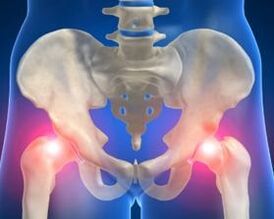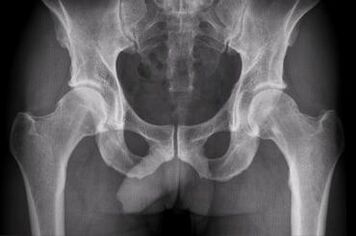
Hip joint arthrosis (cOKSARROSIS) is a chronic and progressive disease in the absence of timely and appropriate treatment, can result in a complete loss of movement in it.The end suggests that it is not an inflammatory, but a degenerative process prevails.
The symptoms of this disease differ depending on the stage.In the beginning, this is almost imperceptible discomfort that occurs by walking and exercise.Perhaps the manifestation in the form of weak pain in the thigh, which at rest passes.In this case, the pain can be felt not only in the thigh, but also in the groin or knee.
As a rule, coxarthrosis is a process that has been leaking for many years, characterized by a gradual change in cartilage, followed by bone deformation and loss of joint functionality.Affecting mainly people after 40 years, but very young patients are also found.
Causes
Why does hip arthrosis occur and what is it?The causes of coxarthrosis may be different, but the image of the disease is always the same.It all starts with changes in joint cartilage, which is thinner and loses the property of amortizing the loads.The body compensates for the stratification of the cartilage tissue by the formation of bone growth along the edge of the joint surfaces, which leads to the deformation of the joints and bones of varying degrees.
The main causes of this joint disease:
- Wound.This cause may not be an important injury, but in many cases chronic microtraums affect the development of the disease that contributes to crack and cartilage thinning.They also affect the anguish of the joint capsule, leading to the accumulation of many damage.Often repeated microtraums are the precursor of the appearance of such a disease.
- Excessive loadsleading to systematic microtrauma as well as joint injuries.Most of the time, this is found in people involved in heavy physical work or professional athletes.In this case, treatment without changing lifestyle or load restrictions is also ineffective and is usually accompanied by relapses.
- Hereditary predisposition.This includes abnormalities in the development of the femoral head itself, the underdevelopment of joint elements and so on.In this case, there is the dysplastic arthrosis of the hip hip.
- Illnesses.For example, arthritis, in the absence of proper treatment, may degenerate in arthrosis over time.This is due to the fact that, during arthritis, the properties of cartilaginous tissue alteration, circulatory disorder occurs.Gradually, this leads to the development of a degenerative process.
- Overweight.Excessive body weight, even when walking, has a load in joints that exceed their physiological limits of strength.
Depending on the cause of disease development and pathogenesis, 2 main types of hip joint arthrosis are distinguished.

- Primary.In this case, the disease develops very slowly and begins with the blood supply impaired to tissues.The reasons for the development of this type of arthrosis are rooted in violation of metabolism, which is more characteristic of people over 50.The primary arthrosis of the hip joint is the most diagnosed.
- Secondary COKSARROSIS.In this case, the disease develops in the context of the systemic inflammatory lesion of many joints in the body.Inflammation may be infectious and autoimmune nature.
At the early stage of patient cOKSARROSIS, just slight pain or a sense of discomfort in the joint area is concerned.Often these signs are ignored as a result of which disease progresses.
Hip Articulation Arthrosis symptoms
Hip joint cOKSARROSIS, whose symptoms cannot be ignored, can lead to serious consequences.There are several basic signs of the disease that depend on the stage of the disease:
- Articulation pain is the most obvious symptom by which any TBS disease can be assumed.The intensity and nature of sensations usually depend on the stage.
- Limiting limb mobility is also a symptom of coxarthrosis.For the early stage, the sensation of the "restriction" of the joint, which passes after some load, is characteristic.
- The weakening of the hip muscles can already be observed in the second stage of the disease, reaching the third to complete atrophy.
- Changing leg length due to pelvis deformation is characteristic of "neglected" osteoarthritis.
- The lame or change of march is a very likely sign of bone deformation.
- A distinct articulation crisis is far from always a sign of arthrosis.Usually taken into consideration if there are other symptoms.
The main feature of thigh is pain, whose nature, its duration, location and intensity depend on the stage of the disease.
1st degree hip articulation arthrosis
This phase of the disease is characterized by joint and thigh pain, sometimes in the knee that occurs after physical activity and disappears after rest.Articulation mobility is not limited and there are no gear violations.
1st degree cOKSARROSIS is the early stage of the disease, starting the treatment of which you can still interrupt the process of destruction and deformation of the joint and preserve its functions in full.Unfortunately, however, many do not consider it necessary to consult a doctor because of weak pain in the joint, and the disease, meanwhile, progresses.
Hip Arthrosis 2 degrees

It manifests itself more clearly - the intensity of pain grows, occurs not only after load, but also at rest, there is a limitation of motor functions.In particular, cOKSARROSIS is characterized by difficulty in performing pronation (thigh rotation) and kidnapping, contracture is formed.
In an X -ray examination, we see a narrowing of joint space and the appearance on the surfaces of bone growth.The revolving cavity and femoral head are deformed.The thigh muscles on the side of the lesion are beginning to atrophy, and pain syndrome spreads below, capturing the knee joint and the inguinal region (it is important to understand that this will not be accompanied by dystrophic changes in the knee joint).
Hip Arthrosis 3 degrees
The signs of the disease are pronounced and constant.Pain syndrome goes beyond night.When walking, the patient uses the support.The leg muscles and the hips are gradually tied, and the sick person's sick leg becomes much shorter.
Frequently, until the third degree, the joint gap disappears completely and the joints grow together in a single bone structure, this demonstrates an image.As a result, complete joint immobility occurs.
Radiographs determine extensive bone growths on the spin -and -headed roof side, an acute narrowing of the joint gap.The femoral neck is significantly expanded and shortened.
Diagnosis
Before finding out how to treat hip joint arthrosis, it is necessary to make a diagnosis correctly.In case of suspected cOKSARTROSIS, a person will aim to conduct a biochemical blood test - in the presence of a disease, patients have a slight increase in VHS, globulins, immunoglobulins and soruumucoid.
The next stage of arthrosis detection is an X -ray photo.He will identify:
- Cartilage delivery,
- bone growths on the cartilage border,
- narrowing the distance between the joints,
- Bone tissue compaction under the cartilage.
Unfortunately, a photo of x -ray does not allow the joint capsule and the cartilage itself, if you need to get information about these soft tissues, the patient will be directed to tomography.
Treatment of hip joint arthrosis
With diagnosed arthrosis of hip joint, treatment will depend directly on the stage at which the disease is located.The general treatment scheme provides for the achievement of the following objectives:
- eliminate pain and discomfort in the painful joint area;
- establish the nutrition of intraarticular cartilage and start the process of its restoration;
- eliminate intra -articular fluid deficiency;
- Activate microcirculation in joint tissues;
- eliminate increased load in the hip joint;
- Strengthen the muscles that surround, protect and maintain the joints;
- Avoid deformation and increase mobility in the thigh joint.
All of this can only be achieved with the help of an integrated approach, which should include not only drug therapy, but also a change in lifestyle in order to get rid of thigh -risk factors.

- In the third stage of the disease, the treatment involves surgery, during which the joint is replaced by an endoprosthesis, while part of the prosthesis is attached to the femur and departs in the pelvic.The operation is quite complicated, a long time and requires a long period of rehabilitation.
- With the degree of arthrosis I and II of the hip joint, the treatment is performed without surgical intervention.Used: anti -non -esteroids, muscle relaxants, chondroprotectors, vasodilating drugs, steroid hormonal drugs, local drugs, pupils, lotions, compresses.
All these medications are prescribed exclusively by the assistant doctor.Some of them are effective in the form of injections directly in the affected joint region.Such injections can only be made by qualified medical staff.Therefore, self -medication is not strictly recommended.
No -Drug Methods
In addition to the use of medicines, doctors recommend non -Drug methods to combat the disease.This includes the following methods of treatment of this disease:
- physiotherapy;
- massage;
- joint creation;
- diet.
Physiotherapy used for arthrosis includes the following types of treatment:
- Magnetotherapy;
- UHF and Ultrasonic Therapy;
- Aerion and Electrotherapy;
- inductothermia;
- phototherapy;
- The use of laser technology.
All of these methods can only be used to improve the blood supply in the joints and relieve spasms.
Drug therapy
The combined treatment of hip arthrosis provides for the appointment of the following groups of medicines:

- Non -steroidal anti -inflammatory drugs, all eliminate pain, alleviate inflammatory processes, but do not restore cartilage tissues.
- Chondoprotectors.Preparations for the nutrition of cartilage tissue.Speeding up your restoration.Important in phase 1.2 of arthrosis treatment.With 3 degrees of disease, the cartilage is already destroyed, these medications will be useless.You need to take drugs for a long time, take some courses.
- MuselaxantesEliminate muscle cramps in the area of painful joints contribute to improving the blood supply of the tissue.
- Ointments and creams.Therapeutic ointments should alleviate the condition of a sick person, but do not contribute to a complete recovery.The hot ointments are well appropriate.They irritate skin receptors and, because of this, reduce pain syndrome.Hot ointments also work to restore the increase of blood circulation in tissues and muscles located around the sick joint.
- Steroid injections in the joint cavity, the injections of these drugs are prescribed to relieve the exacerbation of the disease and eliminate intense pain.
- Vasodilate, expand the vessels within the joint cavity and near it, thus improving the delivery of nutrients needed to restore tissues.
It is not necessary to have popular treatment remedies.But some healers recommend lemon dye, garlic or celery root for joint and bone treatment.
Massage in the treatment of thigh
With the deforming arthrosis of the hip joint, massage treatment provides good results.Massage for Coxarthrosis is a very effective and useful method.It is desirable that the massage be performed by a good specialist and as soon as possible.
Its effect aims to improve blood circulation, strengthen muscles, remove painful spasm, swelling and muscle tension, as well as an increase in diastasis between joint joints.
In the absence of a professional massage therapist, massage can be done yourself.Massage with arthrosis can be performed manually and using various massage devices and even water jets (hydrokines therapy).
Gymnastics
The treatment of hip arthrosis with physical education lies in the performance of two tasks: increasing leg mobility and preventing muscle atrophy.All standard COKSARTROSIS LFK complexes also have a general strengthening nature and a positive effect throughout the body.
The gymnastics exercise complex is prescribed by a specialist.The first pair of medical physical education should occur under the supervision of a doctor.It will show you how to correctly perform each movement and also control the proper load on the hip joints.
Diet
Main recommendations:
- Give porridge in the water.
- Use enough animal protein: fish (except salty), bird meat, beef.
- Use at least 5 portions of vegetables a day (one portion - 100 grams, can be used as a dish).
- Mandatory dairy products: Cottage cheese, yogurt, fermented.
- Delete alcohol, coffee, strong black tea.
- Delete sweet, flour.
- Eat a little, but many times.
The diet will reduce the load in the hip joints and provide everything necessary to restore tissues.


















